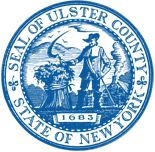On June 29, 2021, New York State recertified Ulster County Agricultural District #1 per Article 25AA § 303-a (agricultural districts review) of New York State Agriculture and Markets Law.
Maps of Agricultural District #1:
- Northern Portion - Esopus
- Southern Portion - Lloyd, Marlborough, Plattekill and Town of New Paltz
- Municipal Boundaries - Entire District
- Topography - Entire District
The maps above come from its periodic review completed in July 2021. The number of tax parcels in an Ulster County Agricultural District is very likely to change after its review. Maps #1 and #2 were created by Ulster County Information Services and submitted to Cornell University's Institute for Resource Information Sciences and the New York State Department of Agriculture and Markets.
The description below was written in 2015 and updated in 2019. An analysis conducted in 2020 and early 2021 of agriculture and related changes to land use in Agricultural District #1 can be downloaded here.
Description of Agricultural District #1
Ulster County apple orchards, located primarily in and around Agricultural District #1, have been a major driver in the County's agricultural and tourism industries. Apple orchards are one of the things Ulster County is known for, especially to residents of the nearby New York City Metropolitan Area. The 2022 United States Census of Agriculture ranks Ulster County as the 10th largest in the nation for acres bearing an apple crop. This places Ulster County 2nd in New York State, behind Wayne County in the Finger Lakes. Clinton, Niagara and Orleans Counties in New York, along with Adams County in Pennsylvania, also rank among the top in acres devoted to apple growing. Other such counties are in different regions of the United States, much farther away from Ulster County. Of all the counties in this group, though, Ulster County is the closest to New York City.
Ulster County’s location has made it a major source of apples to one of the world's major metropolitan areas. And the way Ulster County supplies this demand is not just through deliveries of apples to hundreds of supermarkets, but by drawing people here to pick their own apples. Ulster County apple orchards have long attracted tourists from all over the New York City Metropolitan Area. Tourists come here to "Pick UR Own" apples, and spend a day out in the country - or even longer. Apple orchards became emblematic of agriculture in Ulster County.
Over a decade ago, it appeared Ulster County would lose many of its apple orchards. Orchards were abandoned because it had become tougher to make a living farming. Some apple orchards became suburban subdivisions during the housing boom of the early and mid-2000s. Scores of tax parcels were removed from the District, no longer viable for agriculture.
Then things started to change. The economic downturn starting in 2008 put an end to the housing boom. Also, people's attitudes toward food and what they ate started to change. The demand for unprocessed, locally grown food grew, especially in places like New York City. The demand for apples, along with greens, mushrooms, peppers - fruits and vegetables in general - has meant a shift in the land use patterns here in Agricultural District #1 and throughout Ulster County. Farmland that was subdivided for single-family homes still have apple orchards and other crops growing on them. Plots of land that have not seen agriculture for generations now host farms again, if only small "niche farms". An unofficial junkyard located in Plattekill's portion of Agricultural District #1 reverted back to prime farmland, growing dozens of varieties of crops. The economics have swung back in favor of agriculture in Agricultural District #1 and, for that matter, Ulster County's other three agricultural districts.
Despite changes in the economy, apple orchards continued to develop as tourist draws. Agritourism became an important way to bring in income to supplement farming, especially when farming was not as lucrative. Festivals, weddings and other events joined apple picking as ways to attract tourists. Agritourism continues to evolve as business owners look for new ways to attract tourist dollars. Local zoning and New York State policy on agricultural districts race to keep up with these changes.
While apple orchards are found throughout Agricultural District #1, farms with apple orchards usually grow other crops, too. Farms in the District have long supplied many varieties of fruits and vegetables to stores, and increasingly to CSA's across the Hudson Valley and New York City Metropolitan Area. Like farms elsewhere, farms in the District are catering to new demands as peoples' eating habits change.
Responding to changing eating habits, farmers in the District have started producing hard apple cider. It's a beverage that had established a niche market, but this niche is growing, especially in places like New York City. Cider-centric bars are opening to cater to this increasing demand. The ability of farmers in the District to meet this demand, as they have met others, reflects a dynamism and resiliency emblematic of agriculture in Ulster County as much as apple orchards are. (updated 9/17/2024)
Contact Burt Samuelson of the Ulster County Planning Department with questions at (845) 339-2490 or bsam[at]co.ulster.ny[dot]us

